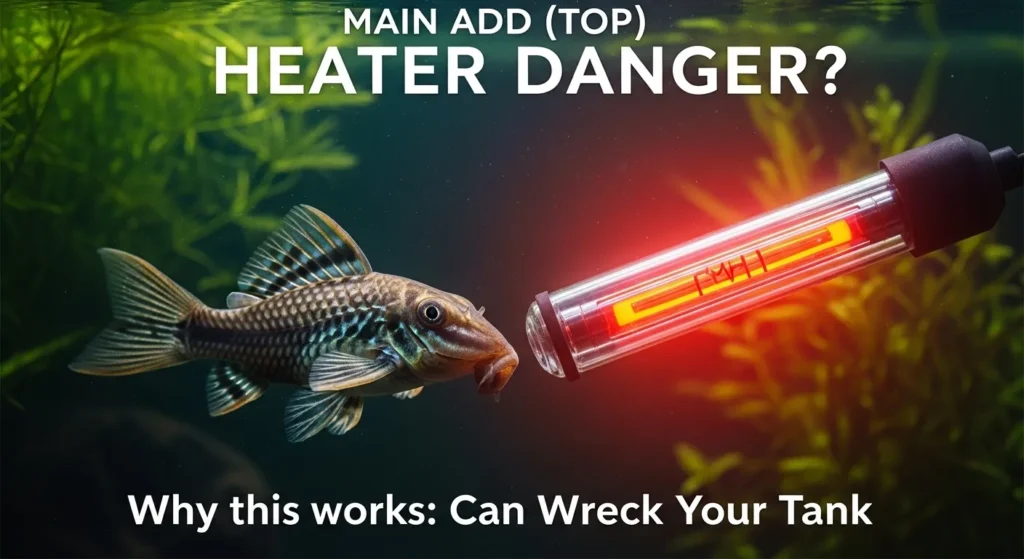You’ve spent a lot of time, effort, and money making your aquarium a beautiful home for your fish. You’ve picked the perfect tank, the best substrate, and the healthiest fish. The last thing you want is for a simple, preventable accident to ruin everything.
This brings us to one of the most common safety questions we hear from new and experienced fishkeepers alike: does my aquarium heater really need a plastic guard?
For the vast majority of aquarists, the answer is a resounding yes. A heater guard is an inexpensive piece of plastic that provides crucial insurance against three critical and costly dangers. It’s one of the simplest, cheapest upgrades you can make to your tank, and it could save you from a world of heartache.
In this guide, we’ll walk you through everything you need to know. We’ll cover exactly why a heater guard is so important, which fish are most at risk, whether different types of heaters need them, and the rare cases where you might be able to go without one.
The 3 Critical Dangers a Heater Guard Prevents
It’s easy to look at a little plastic sleeve and wonder if it can really make a difference. But that simple guard is standing between you and some of the most common disasters in the aquarium hobby. Think of it as a bodyguard for both your heater and your fish.
Here are the three main dangers it protects against.
Danger #1: Protecting Your Fish from Severe Burns
This is the most obvious reason, and it’s a very real risk. While your heater cycles on and off to maintain a stable temperature, the surface of the heating element can get extremely hot—much hotter than the water around it.
If a fish rests against that hot surface for even a few seconds, it can suffer a nasty burn. These burns are not only painful for the fish but often lead to much bigger problems, like secondary bacterial or fungal infections that can be difficult to treat and can even be fatal.
Which fish are most at risk?
- Large, Slow-Moving Fish: Think of fish like Goldfish or large Gouramis. They aren’t as quick to dart away and can sometimes drift into the heater without realizing it until it’s too late.
- Nocturnal Fish: Many of our favorite bottom-dwellers, like Plecos, Catfish, and Loaches, are most active at night. When they look for a place to rest during the day, the dark, quiet corner behind a heater seems like a perfect spot. They can easily settle against the heater while it’s in its heating cycle, leading to serious injury.
- Curious or Territorial Fish: Large cichlids like Oscars or Jack Dempseys are famously curious and can be aggressive toward equipment in their tank. They might try to “attack” or investigate the heater, putting themselves in direct contact with the hot surface.
- Betta Fish: Bettas are known for loving warm water and will often seek out the warmest spot in the tank. They have a habit of resting on or near equipment, and their long, delicate fins are especially vulnerable to getting singed on a hot heater.
A heater guard creates a safe buffer zone. The water flows freely through the slots to get heated, but the plastic sleeve prevents your fish from ever making direct contact with the dangerously hot surface.
Also Read: The 10 Best Fish for a Low-Tech Planted Tank (2025 Guide)
Danger #2: Protecting Your Heater from Being Damaged
Your aquarium heater, especially if it’s a traditional glass model, is one of the most fragile pieces of equipment in your tank. A heater guard acts like a helmet, protecting it from impacts that could easily shatter it.
There are two common ways a heater can get damaged:
- The “Pleco Problem”: This is a classic aquarium accident. A large, strong fish like a Plecostomus, a big Cichlid, or even a clumsy Goldfish can easily knock a fragile glass heater against the tank wall. We’ve also seen large mystery snails crawl onto a heater, lose their grip, and cause the heater to fall or get knocked around. The impact can cause a hairline crack or completely shatter the glass tube, exposing electrical components to the water and creating a very dangerous situation.
- Maintenance Accidents: Let’s be honest, accidents happen. It is incredibly easy to be cleaning your tank and accidentally hit the heater with your gravel vacuum, an algae scraper, or a piece of rock you’re trying to move. That little tap is often all it takes to crack the glass. A heater guard provides a layer of shock absorption, turning a potentially tank-ending disaster into a harmless bump.
Replacing a heater is an expense, but dealing with a shattered heater in a full tank of water is a nightmare. A simple guard can prevent both.
Also Read: The Ultimate Guide to Substrate for a Low Tech Planted Tank (2025)
Danger #3: Protecting Your Tank & Equipment from Meltdowns
This is a danger that many people don’t think about until it’s too late. Most aquarium heaters are held in place with suction cups, and if you’ve been in the hobby for a while, you know that suction cups eventually fail. It’s not a matter of if, but when.
When the suction cups let go, your heater can fall into any position. If an unguarded heater falls and comes to rest against the acrylic wall of your tank, it can literally melt a weak spot into the acrylic. If it lands against a silicone seam in a glass tank, it can soften the silicone, potentially leading to a catastrophic leak.
It doesn’t stop there. A fallen heater can also melt other plastic equipment it comes into contact with, like filter intake tubes, airline tubing, or decorations. This can damage your other gear and release harmful chemicals into the water. A heater guard ensures that even if the heater does fall, its hottest surfaces are kept away from the walls and equipment, containing the danger.

Do All Types of Heaters Need a Guard?
That’s a great question. Heaters come in a few different materials, and while some are tougher than others, they all benefit from the protection of a guard.
- Glass Heaters: Yes, absolutely. These are the most common and most fragile type of heater. They are vulnerable to shattering from impacts and can cause all three dangers listed above. If you have a glass heater, a guard is essential. You can find more details on how they are constructed from leading manufacturers like EHEIM.
- Titanium Heaters: Yes, it’s still highly recommended. Titanium heaters are a fantastic upgrade because they are virtually shatterproof. You don’t have to worry about a large fish breaking one. However, their metal surface gets just as hot—if not hotter—than a glass heater’s. So, while a guard isn’t needed to protect the heater itself from breaking, it is still crucial for protecting your fish from burns.
- Plastic-Encased Heaters: It depends. Some modern heaters come with a heavy-duty plastic casing already built around them, essentially having a built-in guard. If your heater has this feature, you don’t need to add a second one. However, if it’s just a standard heater with a plastic top, it still needs a separate guard to protect the hot element.
When Might You Not Need a Heater Guard? (A Balanced View)
To be completely fair, there is one very specific scenario where you might be able to get away without using a heater guard.
If you have a very small nano tank (think 5 gallons or less) and its only inhabitants are tiny, peaceful creatures like shrimp, nano rasboras, or small snails, the risk is significantly lower. These animals are generally not strong enough to damage the heater, and in such a small space, you might decide that the room the guard takes up is better used for plants or decor.
However, even in this case, the risk is not zero. A heater can still fall, and a curious shrimp could still get burned. Given that a heater guard costs only a few dollars, we believe that for 99% of tank setups, the peace of mind it provides is well worth the tiny amount of space it occupies.
Frequently Asked Questions (FAQ)
Can a fish get burned on an aquarium heater?
Yes, absolutely. The surface of a heater gets much hotter than the surrounding water. Direct, prolonged contact can cause serious burns on a fish’s skin and fins, leading to pain and dangerous secondary infections.
Can my pleco or Oscar break my glass heater?
Yes, this is a very common and costly accident. Large, strong, or even just clumsy fish can easily knock a fragile glass heater into the tank wall, causing it to crack or shatter. A heater guard acts as a protective cage to prevent this.
Is it okay for fish to touch the aquarium heater?
No, it is not okay for fish to touch a hot, unguarded heater. While a quick, passing touch might not do any harm, any form of resting or prolonged contact is dangerous and can cause burns. A guard makes this a non-issue.
Can I make a DIY heater guard?
While some hobbyists do create DIY guards from things like PVC pipe with holes drilled in it, it’s generally not recommended. Commercial guards are made from aquarium-safe plastic and are specifically designed with slots that allow for optimal heat flow and circulation. A poorly designed DIY guard could restrict water flow, causing the heater to work inefficiently or create dangerous hot spots. For the low cost of a commercial guard, it’s the smarter, safer choice.
Conclusion: A Small Price for Priceless Peace of Mind
So, does your aquarium heater need a plastic guard? As we’ve seen, the answer is a clear and confident yes.
For just a few dollars, a simple plastic guard:
- Protects your fish from painful and potentially fatal burns.
- Protects your heater from being shattered by rambunctious fish or maintenance accidents.
- Protects your tank from leaks or meltdowns caused by a fallen heater.
It is one of the cheapest, easiest, and most effective pieces of “insurance” you can buy for your aquarium. It removes a whole category of common, preventable disasters from your list of worries, letting you focus on simply enjoying the beautiful underwater world you’ve created.
Don’t wait for an accident to happen. For the safety of your fish and the security of your entire setup, adding a heater guard is one of the smartest and most responsible upgrades you can make.

Daniel Ravera is the founder of AquaInitium, where he shares insights gained from over a decade of hands-on aquascaping. His expertise lies in the low-tech, ecosystem-first method—a philosophy he adopted after experiencing the common frustrations of algae and instability himself. As an authority in the beginner aquascaping niche, Daniel provides clear, trustworthy advice to help you build a beautiful, stable aquarium and avoid the costly mistakes he learned the hard way.










